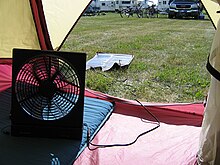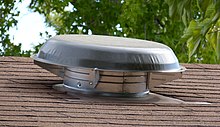
Solar energy is radiant light and heat from the Sun that is harnessed using a range of technologies such as solar power to generate electricity, solar thermal energy, and solar architecture. It is an essential source of renewable energy, and its technologies are broadly characterized as either passive solar or active solar depending on how they capture and distribute solar energy or convert it into solar power. Active solar techniques include the use of photovoltaic systems, concentrated solar power, and solar water heating to harness the energy. Passive solar techniques include orienting a building to the Sun, selecting materials with favorable thermal mass or light-dispersing properties, and designing spaces that naturally circulate air.

Heating, ventilation, and air conditioning (HVAC) is the use of various technologies to control the temperature, humidity, and purity of the air in an enclosed space. Its goal is to provide thermal comfort and acceptable indoor air quality. HVAC system design is a subdiscipline of mechanical engineering, based on the principles of thermodynamics, fluid mechanics, and heat transfer. "Refrigeration" is sometimes added to the field's abbreviation as HVAC&R or HVACR, or "ventilation" is dropped, as in HACR.

In passive solar building design, windows, walls, and floors are made to collect, store, reflect, and distribute solar energy, in the form of heat in the winter and reject solar heat in the summer. This is called passive solar design because, unlike active solar heating systems, it does not involve the use of mechanical and electrical devices.

Solar thermal energy (STE) is a form of energy and a technology for harnessing solar energy to generate thermal energy for use in industry, and in the residential and commercial sectors. Solar thermal collectors are classified by the United States Energy Information Administration as low-, medium-, or high-temperature collectors. Low-temperature collectors are generally unglazed and used to heat swimming pools or to heat ventilation air. Medium-temperature collectors are also usually flat plates but are used for heating water or air for residential and commercial use.

A radiant barrier is a type of building material that reflects thermal radiation and reduces heat transfer. Because thermal energy is also transferred by conduction and convection, in addition to radiation, radiant barriers are often supplemented with thermal insulation that slows down heat transfer by conduction or convection.
A solar chimney – often referred to as a thermal chimney – is a way of improving the natural ventilation of buildings by using convection of air heated by passive solar energy. A simple description of a solar chimney is that of a vertical shaft utilizing solar energy to enhance the natural stack ventilation through a building.
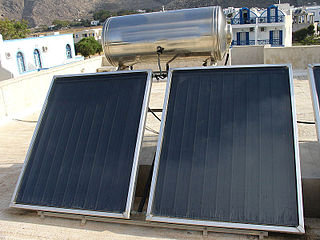
A solar thermal collector collects heat by absorbing sunlight. The term "solar collector" commonly refers to a device for solar hot water heating, but may refer to large power generating installations such as solar parabolic troughs and solar towers or non water heating devices such as solar cooker, solar air heaters.

An attic is a space found directly below the pitched roof of a house or other building. It is also known as a sky parlor or a garret. Because they fill the space between the ceiling of a building's top floor and its slanted roof, attics are known for being awkwardly-shaped spaces with difficult-to-reach corners and often exposed rafters.

A whole house fan is a type of fan, commonly venting into a building's attic, designed to circulate air in an entire home or building. The fan removes hot air from the building and draws in cooler outdoor air through windows and other openings. While sometimes referred to as an "attic fan", this term properly refers to a powered attic ventilator, which exhausts hot air from the attic to the outside through an opening in the roof or gable at a low velocity.
Solar air conditioning, or "solar-powered air conditioning", refers to any air conditioning (cooling) system that uses solar power.
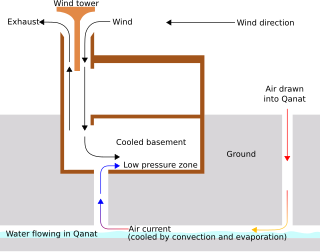
Passive cooling is a building design approach that focuses on heat gain control and heat dissipation in a building in order to improve the indoor thermal comfort with low or no energy consumption. This approach works either by preventing heat from entering the interior or by removing heat from the building.

A powered attic ventilator, or attic fan, is a ventilation fan that regulates the heat level of a building's attic by exhausting hot air. A thermostat is used to automatically turn the fan off and on, while sometimes a manual switch is used. An attic fan can be gable mounted or roof mounted. Additional vents are required to draw in the fresh air as the hot air is exhausted. Attic fans are typically used in warmer months, when temperatures in an attic can exceed 120 °F (49 °C). A fan may be installed in an attic for the different purpose of cooling a whole house, venting hot air out via the attic; such fans are often called whole-house fans.
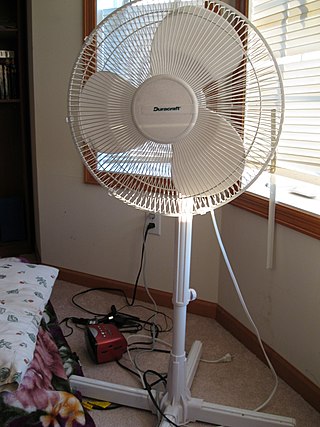
A fan is a powered machine used to create a flow of air. A fan consists of a rotating arrangement of vanes or blades, generally made of wood, plastic, or metal, which act on the air. The rotating assembly of blades and hub is known as an impeller, rotor, or runner. Usually, it is contained within some form of housing, or case. This may direct the airflow, or increase safety by preventing objects from contacting the fan blades. Most fans are powered by electric motors, but other sources of power may be used, including hydraulic motors, handcranks, and internal combustion engines.
HVAC is a major sub discipline of mechanical engineering. The goal of HVAC design is to balance indoor environmental comfort with other factors such as installation cost, ease of maintenance, and energy efficiency. The discipline of HVAC includes a large number of specialized terms and acronyms, many of which are summarized in this glossary.

Solar air heating is a solar thermal technology in which the energy from the sun, insolation, is captured by an absorbing medium and used to heat air. Solar air heating is a renewable energy heating technology used to heat or condition air for buildings or process heat applications. It is typically the most cost-effective out of all the solar technologies, especially in commercial and industrial applications, and it addresses the largest usage of building energy in heating climates, which is space heating and industrial process heating.

An Eco-house (or Eco-home) is an environmentally low-impact home designed and built using materials and technology that reduces its carbon footprint and lowers its energy needs. Eco-homes are measured in multiple ways meeting sustainability needs such as water conservation, reducing wastes through reusing and recycling materials, controlling pollution to limit global warming, energy generation and conservation, and decreasing CO2 emissions.

A dedicated outdoor air system (DOAS) is a type of heating, ventilation and air-conditioning (HVAC) system that consists of two parallel systems: a dedicated system for delivering outdoor air ventilation that handles both the latent and sensible loads of conditioning the ventilation air, and a parallel system to handle the loads generated by indoor/process sources and those that pass through the building enclosure.
Zero-carbon housing is a term used to describe a house that does not emit greenhouse gasses, specifically carbon dioxide (CO2), into the atmosphere. Homes release greenhouse gases through burning fossil fuels in order to provide heat, or even while cooking on a gas stove. A zero carbon house can be achieved by either building or renovating a home to be very energy efficient and for its energy consumption to be from non-emitting sources, for example electricity.

A skylight is a light-permitting structure or window, usually made of transparent or translucent glass, that forms all or part of the roof space of a building for daylighting and ventilation purposes.
SolarWall is the brand name of a transpired collector designed and manufactured by Conserval Engineering. Conserval Engineering is based in Toronto, Ontario, Canada.
